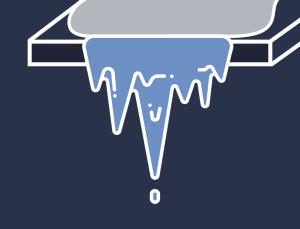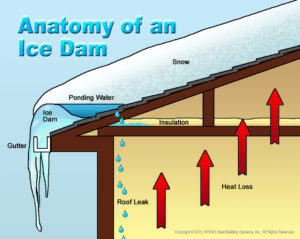Understanding Ice Dams
Winter can be beautiful and picturesque, but it can also wreak havoc on buildings. Those sparkling icicles hanging from your roof could be hiding a major problem: ice dams.
An ice dam is a ridge of ice that develops on the edge your roof, preventing snow from draining off the roof. Ice dams rip gutters from their moorings, loosen asphalt shingles, and warp and rot wood sheathing. The water from snow gets backed up behind the ice dams and leaks into walls and attics, leading to soggy insulation, dripping ceilings, stained sheetrock, and peeling paint. If not corrected quickly, mold and mildew soon follows.
Ice dams cause millions of dollars of building damage every winter. So how can you prevent ice dams? Read on to learn RHINO’s tricks for ice dam prevention.
What Causes Ice Dams to Form?
First, let’s understand how ice dams work.
During the winter, most buildings are heated inside. As the heat rises, it makes the roof warmer than the outside air. This warmth melts the lowest layer of snow, which drains down the slope of the roof. The eave of the roof, however, is much colder than the rest of the roof, as this area is not warmed by interior heat. When the temperature outside reaches below freezing, the water in the gutter or on the edge of the roof freezes, creating icicles.
Over time, the water thaws and refreezes again and again, building up a dam of ice. Soon enough, the ice dam becomes higher than the water level of melting snow on the roof. This reservoir of water collects underneath asphalt shingles, causing them to buckle. Water then begins to seep through the roof, damaging walls, ceilings, insulation, and the contents of the home or building.
Ice Dam Prevention
So what can you do do to prevent ice buildup on a roof and stop ice dams from forming?
REMOVE SNOW
Your first line of defense in ice dam roof prevention is simply to keep snow from accumulating on the roof. Use an ice rake to gently and evenly remove snow from the roof, so that one portion of the roof is not supporting more weight than another section. Leave a marginal amount of snow on the roof. Scraping all the way down to the roof’s surface may damage the shingles or roof covering.  (CAUTION: Be careful not to brush large amounts of snow down on top of you! Heavy falling snow and debris can result in serious injuries.)
(CAUTION: Be careful not to brush large amounts of snow down on top of you! Heavy falling snow and debris can result in serious injuries.)
AVOID GUTTERS
In areas prone to heavy snow, consider shunning gutters. Although gutters do not cause ice dams, they do enable the concentration of water and ice along the roofline. If gutters are already present, run heat tape or heating cables through gutters and downspouts to prevent ice buildup. Check with your insurance company to be sure your coverage allows the use of heat tape or cables.
ADD INSULATION
Heat rising to the roof causes the snow to melt. Adding insulation to the roof or attic reduces heat loss, preventing ice dams. Seal any air leaks that might allow the warm air in the structure to rise to the roof, especially around chimneys, ceiling vents, valleys, and skylights.
INCREASE VENTILATION
Adding small vents in an attic helps keep warm air from gathering underneath the roof. However, if the roof or attic is properly sealed and insulated, vents are unnecessary.
ADD A METAL ROOF
A low-friction roofing material can shed snow better, eliminating ice dam problems. Snow slides off the structure more easily with metal roofing. (CAUTION: In extreme snow locations, large amounts of sliding snow and ice may be dangerous.)
ICE SOCKS
In a pinch, fill a sock or an old pair of pantyhose with a non-corrosive ice melt. Do NOT use rock salt! Carefully place the sock across the ice dam. (CAUTION: Do NOT attempt to do this on a ladder! Position the sock with a snow rake or broom from the ground.)
Let Professionals Handle Ice Dam Removal
Preventing ice dams is the best thing you can do for your home or building. If ice dams have already formed, however, don’t try to remove them yourself. Ice dam removal can be extremely dangerous. It is best to allow professionals who are better prepared and equipped to handle snow removal safely.
Prevent Ice Dams with RHINO Steel Buildings
If you live in a climate where ice dams are common, consider a RHINO Steel building. Steel buildings typically do not have eave overhangs, so ice dams are far less likely to form. In addition, the slicker metal roofing on a steel building sheds ice, water, and snow more easily, so it is less prone to form ice dams.
RHINO steel buildings meet or exceed all snow loads, wind loads, and local building codes for the lifetime of the structure — guaranteed. In addition, RHINO’s extra thick Pro-Value Insulation system keeps warm air inside, rather than letting it radiate through the roof.
Call RHINO today at 940.383.9566 to learn about designing a metal building that prevents ice dams and meets all of your other building needs.
